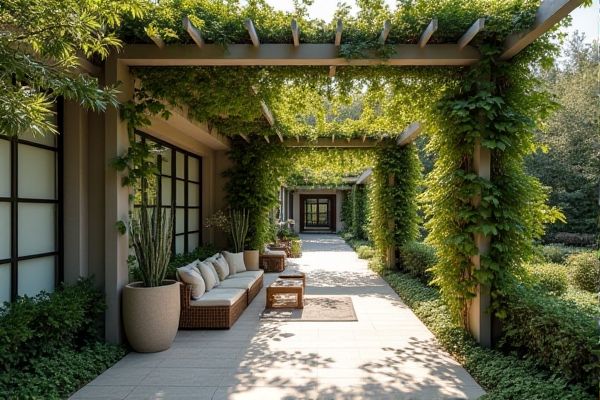
Espalier and trellis are both techniques for training plants, but espalier involves guiding trees or shrubs into flat, ornamental shapes against walls or fences, maximizing space and light exposure. If you're considering your garden design, explore the differences in structure and benefits to decide which method best suits Your landscape needs by reading the rest of this article.
Table of Comparison
| Feature | Espalier | Trellis |
|---|---|---|
| Definition | Pruning and training fruit trees to grow flat against a structure. | Framework of lattice used to support climbing plants. |
| Purpose | Maximize fruit production in small spaces; decorative. | Support and guide climbing plants for growth. |
| Plant Types | Fruit trees (apple, pear, etc.). | Climbing plants (vines, roses, ivy). |
| Structure | Flat, trained branches against flat surfaces. | Freestanding or attached lattice framework. |
| Maintenance | High - requires regular pruning and training. | Low to moderate - mainly structure upkeep. |
| Space Efficiency | Very high - ideal for small gardens. | Moderate - depends on trellis size. |
Introduction to Espalier and Trellis Methods
Espalier and trellis methods are popular techniques in garden design for training plants to grow flat against a structure, maximizing space and improving air circulation. Espalier involves pruning and training trees or woody plants into formal, structured shapes along a support, often a wall or fence, while trellis systems provide a framework of latticework for climbing plants like vines to ascend naturally. Your choice between these methods depends on the plant type and the desired aesthetic or functional outcome in your garden.
Key Differences Between Espalier and Trellis
Espalier involves training and pruning a tree or shrub to grow flat against a frame, creating a living, decorative, and productive plant structure. A trellis is a supportive framework made of wood, metal, or plastic that provides a surface for climbing plants but does not alter the plant's natural growth pattern. You can use espalier for fruit trees to maximize space and sunlight, while trellises suit various vines and flowers needing vertical support without precise shaping.
Historical Background and Origins
Espalier, originating from ancient Roman and French horticulture, involves training trees or shrubs to grow flat against a structure, maximizing space and fruit production in limited areas. The trellis, with roots tracing back to classical Mediterranean gardens, serves as a supportive framework for climbing plants, creating vertical gardens and enhancing aesthetic appeal. Your garden can benefit from understanding these traditional techniques, each reflecting centuries of cultivation tailored to different plant growth habits and landscape uses.
Design Principles and Aesthetic Appeal
Espalier involves training trees or shrubs to grow flat against a frame or wall, emphasizing structured geometric patterns that blend horticulture with architectural form. Trellis design prioritizes flexibility, using lattice frameworks to support climbing plants, creating vertical gardens with natural, organic shapes. Espalier offers a refined, formal aesthetic, while trellis systems provide a more casual and varied visual appeal for garden spaces.
Space Efficiency and Garden Suitability
Espalier offers superior space efficiency by training plants flat against walls, making it ideal for small gardens or narrow spaces. Trellises provide vertical support allowing plants to grow upwards, suitable for larger areas where height is less restrictive. Your choice depends on garden dimensions and the desired use of available space, with espalier maximizing compact areas and trellises accommodating more extensive growth.
Plant Types Best Suited for Each Method
Espalier is best suited for fruit trees like apples, pears, and cherries that benefit from structured pruning and training against flat surfaces to maximize sunlight exposure and fruit production. Trellises are ideal for climbing plants such as grapes, passionflowers, and cucumbers, providing vertical support to encourage upward growth and ease of harvesting. Both methods improve space utilization in small gardens, but espalier requires more maintenance and skill to shape trees versus the more flexible support offered by trellises.
Installation and Maintenance Requirements
Espalier installation involves training and pruning your plants against a framework, requiring precise initial setup and regular maintenance to ensure proper growth patterns. Trellis installation is generally simpler, involving securing the trellis structure and guiding plants as they climb, with less frequent maintenance needed. Espalier demands more ongoing attention compared to the relatively low-maintenance trellis system.
Growth Patterns and Pruning Techniques
Espalier growth patterns involve training branches to grow flat against a structure, typically in symmetrical, two-dimensional shapes like fans or candelabras, requiring precise pruning to maintain form and encourage fruit production. Trellis systems support plants to grow vertically or diagonally, allowing for freer, more natural growth patterns with less intensive pruning primarily focused on removing dead or overcrowded branches. Effective pruning techniques for espalier emphasize regular, strategic cuts to shape and control branch angles, while trellis pruning concentrates on managing vigor and air circulation.
Pros and Cons: Espalier vs Trellis
Espalier offers precise control over plant shape and maximizes garden space by training branches flat against a support, making it ideal for small areas and decorative fruit production but requires regular pruning and maintenance. Trellis structures provide versatile support for a wide range of climbing plants, promoting vigorous growth and easy installation but can result in less structured plant forms and may require more frequent replacement depending on material. Choosing between espalier and trellis depends on garden design goals, plant type, and willingness to invest time in maintenance versus flexibility and growth vigor.
Choosing the Right Method for Your Garden
Espalier and trellis are both effective techniques for training plants, but espalier is ideal for maximizing space and creating formal, two-dimensional shapes against walls, making it perfect for small gardens or decorative purposes. Trellis structures provide versatile vertical support for climbing plants, allowing more natural growth patterns and easier maintenance, suitable for larger or less formal spaces. Selecting the right method depends on your garden's size, aesthetic goals, and the specific plants you intend to grow.
 homyna.com
homyna.com